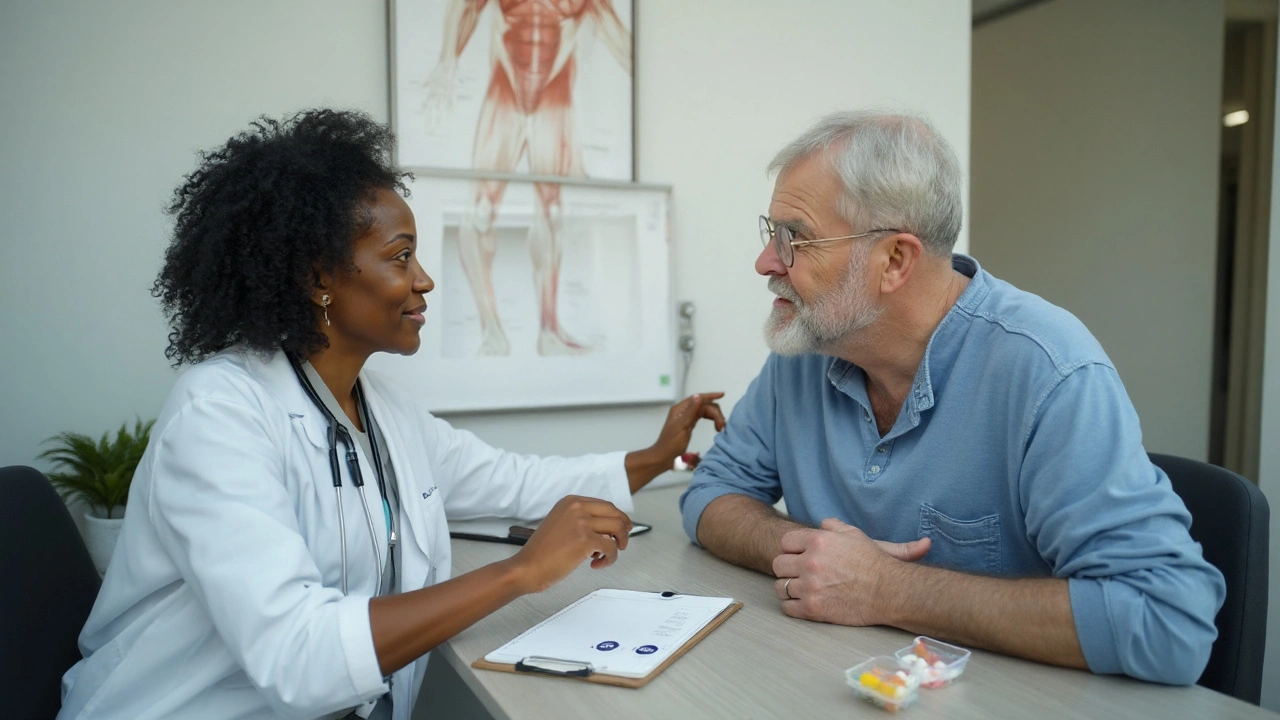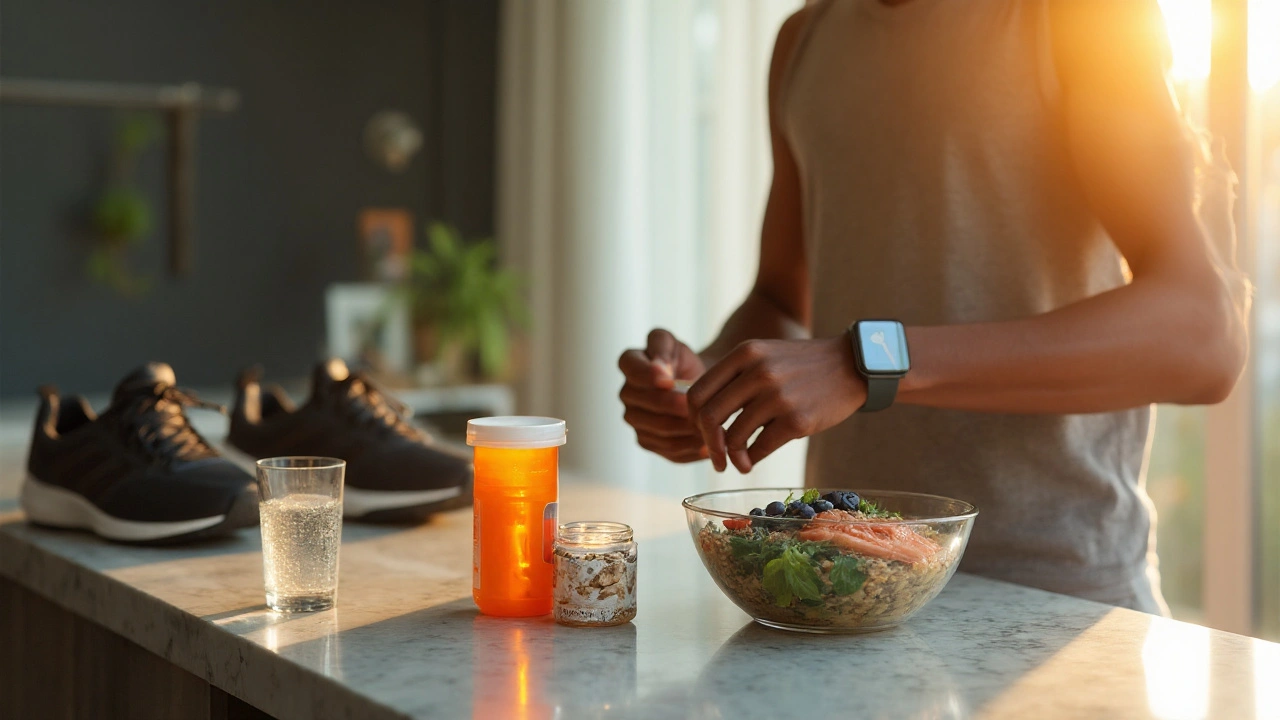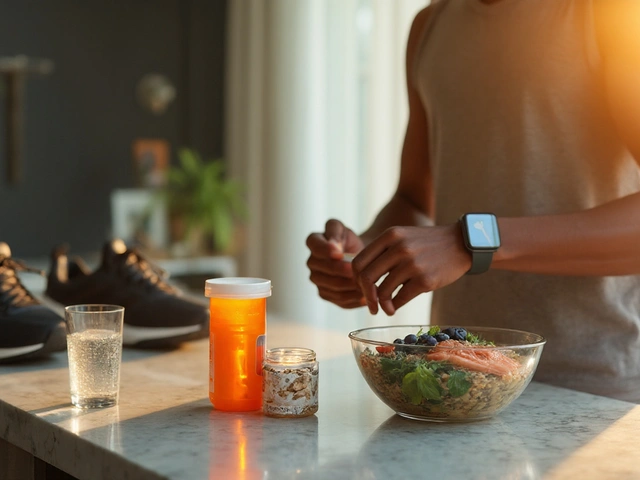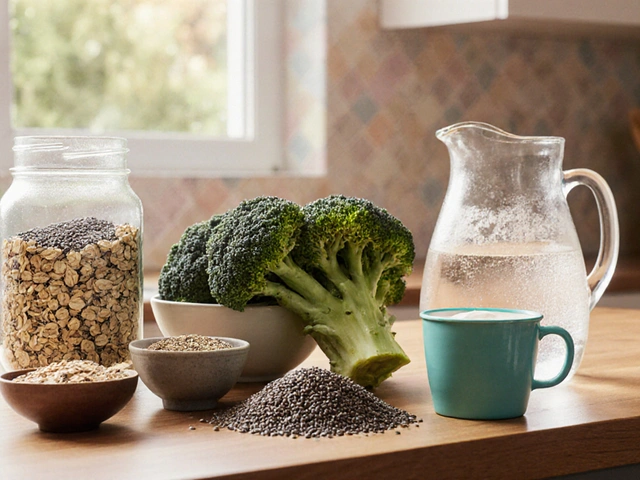If your cholesterol is finally heading in the right direction but your muscles ache, your sleep is off, or your stomach’s not happy, you’re not alone. This guide shows you how to calm common Rosuvastatin side effects using safe, natural add-ons-without ditching the statin that protects your heart. I’ll be straight with you: natural remedies can’t replace your prescription, and they don’t fix every issue. But the right ones, used the right way, can make life on rosuvastatin much more comfortable.
- TL;DR: Try CoQ10 (100-200 mg/day) for muscle aches, correct low vitamin D, move daily but gently, hydrate, and switch your dosing time if sleep or nausea is an issue.
- Check labs and basics first: low vitamin D, low magnesium, untreated thyroid issues, dehydration, and overtraining can all mimic or worsen statin woes.
- Call your doctor fast for severe muscle pain, weakness, dark urine, fever, or yellow eyes/skin.
- Avoid red yeast rice and high-dose turmeric while on rosuvastatin-both can backfire.
- Rosuvastatin plays nicer with grapefruit than other statins, but don’t go wild. Keep it moderate.
TL;DR: Quick wins to feel better this week
Before we go deep, here’s the short list most people find helpful. These are safe for most adults, but check with your GP or pharmacist-especially if you take blood thinners, diabetes meds, or have kidney or liver issues.
- Coenzyme Q10: 100-200 mg/day with your main meal. Evidence is mixed but leans positive for statin-related muscle aches. It’s the first thing many cardiology clinics try for muscle symptoms.
- Vitamin D (if low): Ask for a 25(OH)D blood test. In Australia, deficiency is usually <50 nmol/L. If you’re low, correct it under medical advice-this alone can ease muscle pain for some.
- Magnesium (for cramps): 200-400 mg elemental magnesium at night. Go for glycinate or citrate forms if you get loose stools. Avoid if you have significant kidney disease unless approved.
- Gentle movement daily: Short walks, light cycling, or mobility work help clear stiffness better than total rest. Ease back in; don’t prove a point.
- Hydrate and add electrolytes: Mild dehydration makes cramps, headaches, and fatigue worse. Aim for pale-yellow urine; add a pinch of salt or an electrolyte tab if you sweat a lot.
- Timing tweaks: Rosuvastatin can be taken morning or night, with or without food. If you feel wired at night, move it to the morning. If you get nausea, take it with dinner.
- Anti-inflammatory add-ons: Omega‑3s (EPA/DHA 1-2 g/day) and tart cherry (concentrate 30-60 mL in water) can reduce post-activity soreness. Watch sugar if using juice.
What to skip: red yeast rice (it’s basically another statin), high-dose turmeric/curcumin (possible interaction), and niacin “for cholesterol” (can worsen side effects and blood sugar).
Step-by-step plan to tame symptoms (by what you feel)
Rosuvastatin’s most common issues are muscle aches, headaches, gut upset, sleep changes, and mild blood sugar bumps. Less common but important: serious muscle injury (rare) and liver enzyme elevations. Here’s how to match symptoms to fixes.
1) Muscle aches, stiffness, or weakness (SAMS: statin-associated muscle symptoms)
- Rule out look-alikes: Low vitamin D, low magnesium, low thyroid (TSH), intense new workouts, viral infection, and dehydration can all feel like “statin pain.” Ask for labs: CK (if symptoms), 25(OH)D, TSH, electrolytes, kidney and liver function.
- Try CoQ10: 100-200 mg/day with food for 4-6 weeks. A 2020 meta-analysis across randomized trials found modest pain score improvements in statin users. Not a miracle, but worth a fair trial.
- Correct vitamin D if low: Large prevention trials didn’t show vitamin D stops statin aches for everyone, but smaller studies suggest fixing deficiency helps some people with pain. If you’re under 50 nmol/L, your GP can guide dosing until you’re in the healthy range (often 50-125 nmol/L).
- Magnesium for cramps: 200-400 mg elemental nightly. Glycinate is gentler on the gut; citrate helps if you’re constipated.
- Ease back into activity: 10-20 minutes of low-impact cardio or a short walk after meals. Gentle stretching and a warm shower can help the stiffness without aggravation.
- Heat and cold: Warmth for stiffness, brief cold packs for hot, inflamed areas. Use whichever gives relief.
- If pain is new and severe, or you feel true weakness (not just soreness), stop the statin and call your doctor the same day-especially with dark urine, fever, or malaise.
What your doctor may do if symptoms persist: lower the dose, switch to alternate-day dosing, or change you to a different statin or a non-statin add-on (ezetimibe, bempedoic acid, or PCSK9 inhibitors). Natural helpers are there to support, not replace, those decisions.
2) Headache and fatigue
- Fluids first: Headaches often improve with hydration and stable meals. Add an electrolyte if you’re outdoors a lot (hello from Adelaide summers).
- Omega‑3s: 1-2 g EPA/DHA daily may reduce inflammatory headaches over weeks.
- Magnesium: Night-time magnesium helps tension-type headaches for some. Start at 200 mg and adjust.
- Caffeine timing: Keep caffeine earlier in the day and consistent. Big swings trigger headaches.
- Sleep moves: Get morning sun and keep your sleep/wake time steady. Even 15 minutes outdoors helps your body clock.
3) Nausea, reflux, or loose stools
- Take rosuvastatin with your main meal if your stomach is sensitive.
- Ginger: 500-1000 mg/day in divided doses, or fresh ginger tea, can settle nausea.
- Probiotics: A daily multi-strain probiotic or yogurt/kefir for 2-4 weeks can calm a jumpy gut. Look for Lactobacillus and Bifidobacterium species.
- Fiber balance: 25-30 g/day total. For diarrhea, add soluble fiber (oats, psyllium 1 tsp in water). For constipation, add water plus psyllium or kiwi fruit.
- Trigger sweep: If spicy or heavy meals make it worse, go bland and smaller for a week, then reintroduce slowly.
4) Sleep changes or restlessness
- Switch dosing time: Try mornings if you feel wired at night.
- Magnesium glycinate (200-300 mg) about an hour before bed supports relaxation.
- Light discipline: Keep evenings dim and screens warm-toned; get bright light within an hour of waking.
- Keep evening exercise easy: Do your intense workouts earlier in the day.
5) Mild blood sugar bump
All statins can nudge glucose up a little. For most people, the heart benefit far outweighs that small shift.
- Protein + fiber at each meal: Eggs and veg at breakfast; tuna and beans at lunch; salmon and broccoli at dinner. Keeps glucose steadier.
- 10-minute walk after meals: Quick way to flatten glucose spikes.
- Omega‑3s and extra-virgin olive oil: Help triglycerides and may improve insulin sensitivity a touch.
- Cinnamon (Ceylon): 1-2 g/day can shave post-meal glucose in some people. Not a drug; just a small assist.
6) Liver concerns (rare but important)
- Keep alcohol modest: No heavy sessions. If your doctor flagged raised enzymes, skip alcohol until sorted.
- Avoid “liver cleanses” and potent herb stacks: Milk thistle, high-dose turmeric/curcumin, or multi-herb blends can alter drug transporters. Not worth the risk without medical oversight.
- Report yellowing skin/eyes, dark urine, or severe fatigue right away.
Quick myth check:
- Grapefruit: Big issue for simvastatin and atorvastatin. Rosuvastatin is less affected. One small glass is usually fine; don’t chug liters daily.
- Red yeast rice: It’s a natural statin (monacolin K). Doubling up increases side-effect risks. Skip it while on rosuvastatin.

Real-world examples, dosages, and a handy checklist
Here’s how real people string this together without turning their pantry into a pharmacy.
Example 1: Muscle aches after two weeks
You’ve started getting thigh and shoulder soreness that lingers. Strategy:
- Ask your GP for 25(OH)D, CK, TSH, and basic electrolytes.
- Start CoQ10 100 mg with dinner. If no change after two weeks, go to 200 mg.
- Add magnesium glycinate 200 mg at night.
- Swap two gym days for 20-minute brisk walks; add a warm shower after.
- Hydration target: 2+ liters/day, more if it’s hot.
Reassess in 3-4 weeks. If worse or you feel weak, call earlier.
Example 2: Night-time restlessness
You can’t settle after your dose.
- Move your rosuvastatin to the morning.
- Magnesium glycinate 200-300 mg 60 minutes before bed.
- Evening routine: dim lights, stretch 5 minutes, no emails after 9 pm.
Example 3: Nausea and loose stools
Stomach not loving it?
- Take rosuvastatin with dinner.
- Ginger 500 mg twice daily, or fresh ginger tea after meals.
- Probiotic daily for 2-4 weeks; add 1 tsp psyllium in water with breakfast.
Dosage snapshot (typical ranges)
- CoQ10 (ubiquinone or ubiquinol): 100-200 mg/day with food.
- Vitamin D3: Only if low-dose guided by your GP to reach safe blood levels (often 50-125 nmol/L in AU labs).
- Magnesium (glycinate/citrate): 200-400 mg elemental at night.
- Omega‑3s (EPA/DHA): 1-2 g/day with food. If you’re on blood thinners, ask first.
- Ginger: 500-1000 mg/day split doses, or fresh ginger tea.
- Tart cherry concentrate: 30-60 mL in water, 1-2 hours before bed for soreness/sleep.
What to stop or avoid
- Red yeast rice, high-dose niacin
- High-dose turmeric/curcumin capsules (possible drug-transporter interaction)
- Heavy alcohol while troubleshooting liver enzymes or muscle symptoms
| Side effect | How common (approx.) | Try first | Evidence snapshot | Safety notes |
|---|---|---|---|---|
| Muscle aches/stiffness | 5-10% | CoQ10; correct low vitamin D; gentle activity; magnesium at night | CoQ10: small benefit in RCT meta-analyses; Vit D helps mainly if deficient | Seek care for severe pain, weakness, dark urine |
| Headache | Up to 5% | Hydration, magnesium, steady caffeine, omega‑3s | Magnesium helps tension-type headaches; omega‑3s modest anti-inflammatory effect | Rule out dehydration and eye strain |
| GI upset | 3-7% | Take with food; ginger; probiotics; adjust fiber | Ginger effective for nausea; probiotics support gut comfort | See GP if persistent or with bleeding/fever |
| Sleep changes | Uncommon | Morning dosing; magnesium glycinate; light routine | Behavioral sleep strategies well supported | Rule out caffeine/late workouts |
| Mild glucose rise | Small increase in some | Protein+fiber meals; 10‑min post‑meal walks; omega‑3s | Lifestyle changes reduce post‑prandial spikes | Monitor if prediabetes/diabetes |
| Liver enzyme bump | Rare | Limit alcohol; avoid herb “cleanses” | Most mild elevations settle; monitor labs | Urgent care for jaundice or dark urine |
Quick checklist (print this)
- Hydration: Pale-yellow urine most of the day
- Daily movement: 20-30 minutes easy pace
- Supplements on board (if approved): CoQ10, magnesium; vitamin D if low
- Meal timing: Take with food if your gut is sensitive
- Sleep: Consistent bedtime, morning light, wind-down routine
- Red flags: Severe muscle pain/weakness, dark urine, fever, yellow eyes/skin → call same day
- Follow-up: Recheck symptoms in 2-4 weeks; labs as advised
Mini‑FAQ and what to do next
I kept these tight-these are the things people ask me the most.
Can I stop my statin if I feel better with supplements? No. Natural add-ons reduce symptoms; they don’t replace the proven heart protection of statins. Talk to your GP if you want to try dose changes or alternate-day dosing.
Is rosuvastatin better than other statins for side effects? For many, yes. It tends to cause fewer interactions and can be taken any time of day. If you struggled on simvastatin or atorvastatin, rosuvastatin is often the next move.
Does grapefruit interact with rosuvastatin? Not like with simvastatin or atorvastatin. Moderate intake is usually okay. If you love grapefruit, keep portions small and consistent and check with your pharmacist.
What lab tests should I ask for if I’m sore? CK (if symptoms), 25(OH)D, TSH, electrolytes, kidney and liver function. These catch common and fixable causes.
What about turmeric, CBD, or milk thistle? I don’t recommend high-dose turmeric/curcumin capsules with rosuvastatin-possible transporter interactions. CBD can interact with several meds; speak to your GP. Milk thistle data are mixed and not worth the risk if you’re troubleshooting enzymes.
Can I take red yeast rice with rosuvastatin? No. It’s like adding a second statin. That ups your risk of muscle injury without extra benefit.
Is CoQ10 safe long-term? Generally yes for healthy adults. Take with food. If you’re on warfarin or other anticoagulants, ask your pharmacist first.
Should I train through the pain? Ease back, don’t stop moving completely. Low-intensity, short duration, and build up slowly. If you feel weaker, not just sore, stop and call your GP.
Any special notes for Australia? Vitamin D is commonly low by the end of winter-even in sunny states. Ask for the blood test. Supplements are regulated by the TGA; stick to reputable brands and talk to your pharmacist about specific products.
When to call your doctor fast
- Sudden severe muscle pain, real weakness, or you can’t climb stairs
- Dark, cola-colored urine
- Fever, confusion, or feeling very unwell
- Yellowing eyes/skin, severe stomach pain, or persistent nausea/vomiting
Who should be extra careful with supplements
- People on blood thinners (warfarin, DOACs): check omega‑3s, ginger, and CoQ10 with your pharmacist
- Kidney disease: magnesium and high-dose supplements may not be safe without supervision
- Liver disease: avoid herb stacks; stick to GP-approved plans
- Pregnant or breastfeeding: get medical advice before adding anything
Simple decision path (print this next to your meds)
- Mild aches or GI upset? Try timing tweaks + hydration + CoQ10 (100-200 mg) + magnesium (200-400 mg at night) for 2-4 weeks.
- No change? Check labs (25(OH)D, CK if symptoms, TSH, electrolytes). Correct deficiencies.
- Still struggling? Ask about dose change, alternate-day dosing, or switching statins/non‑statins.
- Severe symptoms or red flags? Stop the statin and call your doctor today.
Why trust these tips
They line up with how cardiology and lipid clinics manage statin intolerance. The National Lipid Association’s statin intolerance guidance (2022) and the ACC/AHA cholesterol guideline (2018, with updates) both suggest checking for correctable causes, considering dose timing and alternative dosing, and using supportive measures like CoQ10 when muscle symptoms appear. Large randomized trials (e.g., JAMA Cardiology 2022) found vitamin D doesn’t prevent statin pain in the general population, which is why I recommend testing and correcting deficiency rather than blind supplementation. CoQ10’s evidence is mixed but shows small reductions in pain in pooled RCTs, enough for a practical trial. Omega‑3s, ginger, probiotics, and magnesium have independent evidence for the specific symptoms they target (inflammation, nausea, gut comfort, cramps and sleep), and they’re generally safe when used sensibly.
Practical note from real life: I’m a parent in Adelaide. Energy matters. I care less about perfect lab theory and more about whether you can chase your kids, ride the Torrens, or make it through a busy shift. These steps aim for that.
Your next step today
- Pick one: CoQ10 or magnesium tonight. Start simple.
- Book a quick chat with your GP or pharmacist this week about vitamin D and a basic blood check if muscle pain is new.
- Set a 10‑minute walk after dinner for the next five nights. See how you feel.
Keep the statin doing its heart-protecting job, and use these small, smart tweaks to make the day-to-day easier. If you hit a wall, don’t push through in silence-loop in your care team and adjust the plan.







Post A Comment